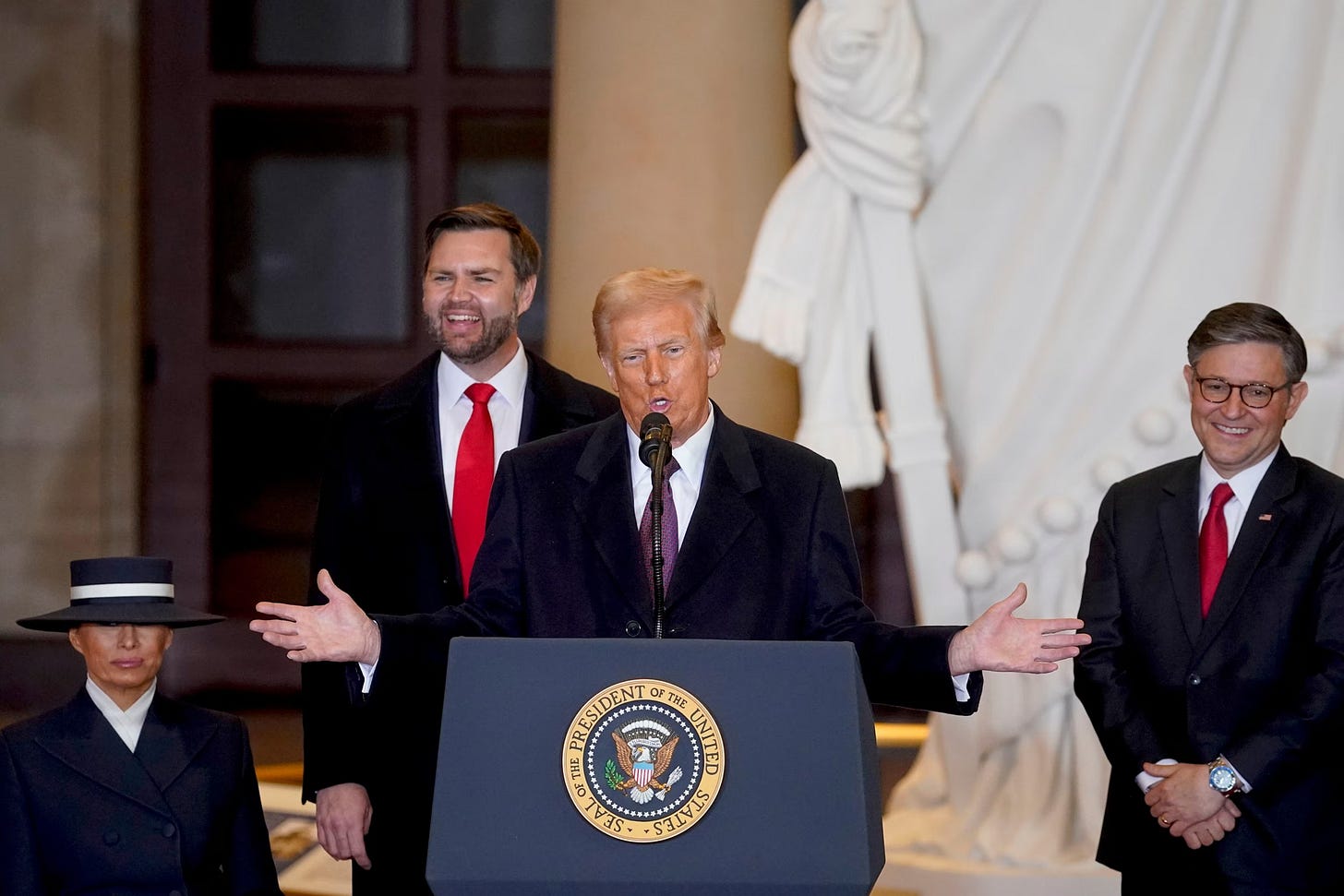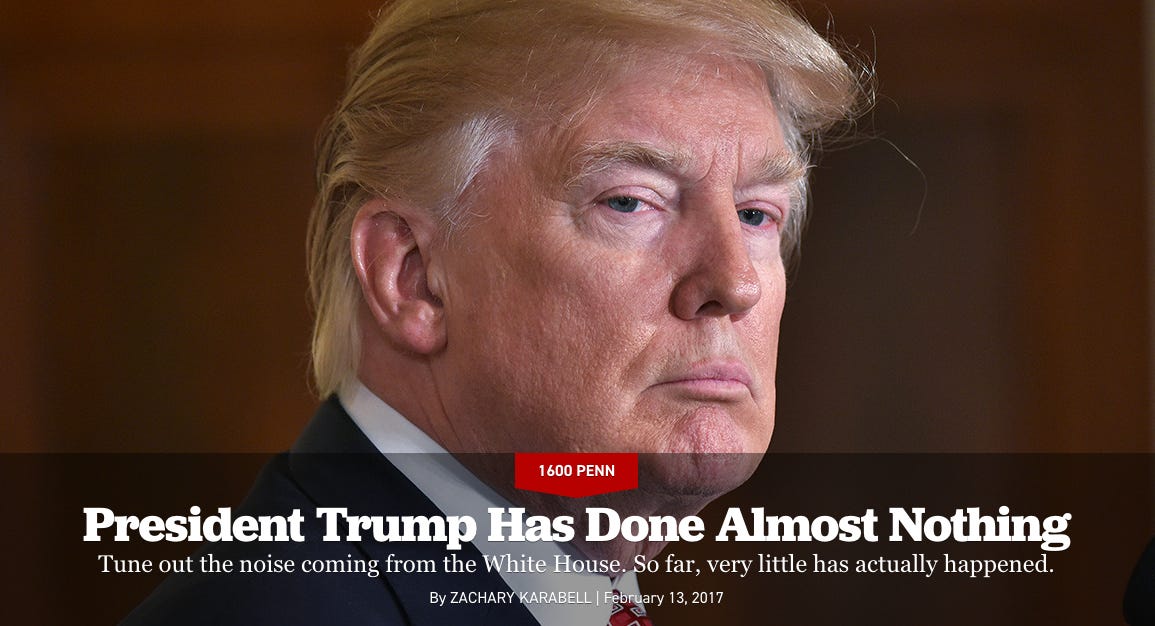So here we are, the beginning of the second Trump administration in the United States, January 20, 2025. In a rather subdued inaugural address, Trump promised a new “golden age,” which, on the face of it, is hardly something anyone would object to. As for the rest, well, it was an unsurprising rehash of much of what Trump campaigned on, from cracking down on illegal immigration and removing immigrants to raising tariffs to reversing diversity programs. It was a speech that will please his supporters and dismay his detractors, which means it was a speech much like hundreds of others he has delivered.
The past few months have been a welcome lull. The temptation now will be to pick up where we last left off, with hyperbole and outrage and despair and anger and sanctimony and triumphalism and tit-for-tat. It’s imperative in the time ahead to resist that temptation. For those dismayed by Trump’s presidency, it’s worth remembering the legacy of his first term, when unrelenting opposition to nearly everything he said or did contributed to a sense of perpetual crisis—with few tangible outcomes. If you view Trump triumphantly, remember that his margin of the popular vote was the smallest since 2000, that the Republican majority in the House is the smallest since 1931, and that there remains a massive education and gender divide that the election revealed and did nothing to heal.
What followed the inaugural address was a slew of executive orders, which mirrors what happened in January 2017 in the first Trump administration. Back then, many of those orders were widely assumed to establish firm policy—yet many were not, a pattern likely to repeat itself now. This time, as before, the signing of these orders was a carefully staged piece of political theater, designed to signal that significant changes are underway. Take the declaration of a “national emergency” at the southern border as a way to unlock funding for things such as a border wall and to circumvent more arduous bureaucratic procedures for enacting policy.
Yes, Congress has ceded power to the president to declare a wide variety of national emergencies, and much of the language enabling those is frustratingly and dismayingly vague. But what that then actually allows the president to do is equally vague, open to interpretation and subject to legal challenge. For instance, renaming the “Gulf of Mexico” as the “Gulf of America” might technically fall within presidential authority, but the federal government is far from the sole arbiter of geographical nomenclature—outside its own use in executive branch documents.
Whatever excesses of executive authority that Trump may exercise are almost entirely the product of Congress ceding power over the past decades. Whatever use of executive orders that Trump now avails himself of is the product of the past few presidencies, where Bush, Obama, Trump and then Biden turned to executive orders because of congressional inaction on legislation. Even so, recent presidents have actually issued fewer orders than presidents early in the 20th century, where Wilson and FDR – and even Calvin Coolidge - each issued over 1000. The past four presidents have issued a few hundred each.
Given that Trump purposely created a pomp and circumstance signing ceremony for the executive orders, it’s doubly vital not to treat those orders as law by the stroke of an executive pen. That’s the thing about the U.S. presidency. Outside of military action abroad and the latitude to pardon, the power to just do X at the flick of a wrist is mostly elusive. But it’s easier for proponents, opponents and the media to treat the certainty of these orders as a done deal. They aren’t.
In that sense, not only do we have to see what Trump does rather than just listen to what he says, but we also have to see how much of what he does actually gets done. Outrage and fervent loyalty both demand an immediacy. The reality of how presidential power gets implemented in the United States is much muddier, much less immediate and unfolds in messier, inconclusive ways.
So, Trump can, as he did, declare a “national energy emergency” designed to increase production of American oil and gas in the belief that doing so will offset inflation. Yet, as the CEOs of the major oil companies attest, the only thing that will lead to more production is more demand and higher prices, not whether Washington does or does not want it. Exxon does not “drill baby drill” because the president of the United States wants it to; it drills if the cost of exploration, extraction and refining are more than offset by the price of oil and the demand for it.
The mass pardoning of most individuals convicted for the events of January 6, however, stands out as a concrete use of presidential might. The presidential pardon power is extensive and unchecked. But pardoning 1600 people for crimes committed four years ago is a specific use of power that doesn’t translate into a systemic shift. It may (or may not) be outrageous, but it is also limited and specific, and perfectly within the purview of the president.
We should all hope for a “golden age.” At the same time, it’s worth recognizing that the past decades have been neither as dark as partisans aver nor as golden as rose-tinted glasses suggest. The 1950s, for instance, were a time of unparalleled prosperity for the middle-class, yet in material terms, the middle-class of the 2000s enjoyed larger homes, more leisure time, more and greater access to affordable energy and food. The Civil Rights Act of 1964 was passed because the 1950s prosperity did not extend to political participation for vast numbers of non-whites.
The story of America’s past is a wonderful, muddy mix of the great, the good and the ugly. The story of America’s present may follow the same pattern. And as for the story of America’s future, that is yet to be written. It’s important not to assume we know the trajectory we’re on. The challenge of Trump Part Deux lies in the seductive rush to certainty. We want to conclude we know what the outcome will be, now! We want to decide what Biden’s legacy will be, now! But most reality unfolds more elliptically, and it takes a long while to know.
So, as we prepare for the second season of the Trump show, let’s keep in mind – once again – that words aren’t actions, and that even actions aren’t always what they seem. Trump is a tempting show, and one we should watch from time to time. But it is just one show amongst many, and it’s often not the one that matters most.






Thank you for helping me stay "balanced ". That's my goal- figuratively and literally at 83.
I really like the calm, objective tone of this. I'm quite progressive, but also quite old (74) and I've seen numerous swings from more conservative to more progressive. Real, substantive change comes slow and often more at the bottom than the top. While we talk about the US Prez as the most powerful person in the world, much of what happens is out of his control (though unfortunately presidents often get blamed or lauded anyway). Thank you for your perspective.